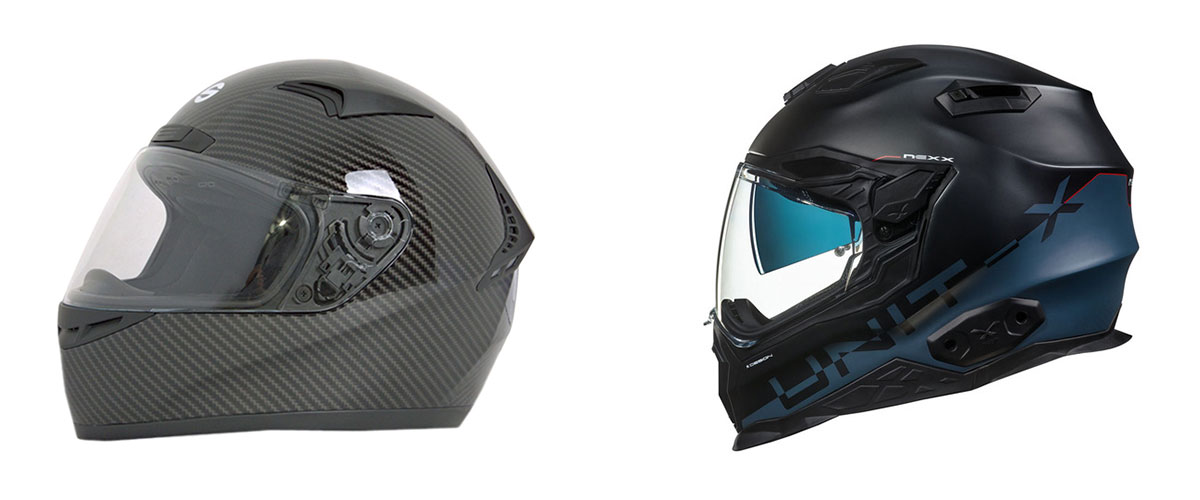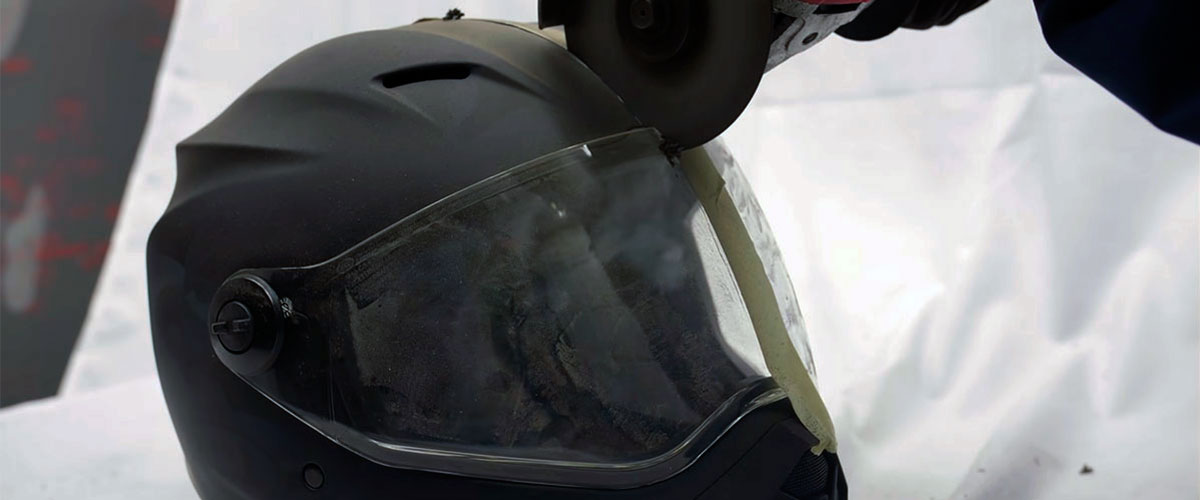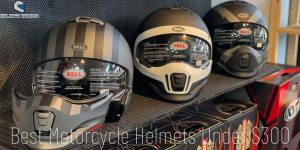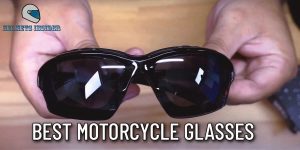While there are many factors that should be taken into consideration when selecting a helmet, the motorcycle helmet materials used in its construction should be on top of the list. Read on to find out what materials are usually used in the production of motorcycle helmets and see what advantages each of them offers.
Motorcycle helmet construction
Whatever helmet you take, it is going to be made of at least three layers: an outer shell, an impact-absorbing liner, and a comfort liner. However, they are not created equal. To get the best protection possible, I recommend you first learn what helmets are made of in detail.
Outer shell
The outer shell is the most important part of a helmet that plays an essential role in minimizing the crash impact. To specify, it spreads the force over a wider area of a helmet, preventing any sharp objects from getting inside. The outer shell can be made of either ABS, polycarbonate fiberglass, or Kevlar; however, you can also find variations made of a mix of various more complex fiber types.
Impact-absorbing liner
To mitigate brain injuries and skull fractures, manufacturers equip the inside of a helmet with a special impact-absorbing liner. Comprising multiple layers of soft padding, this liner aids in absorbing the impact energy or crush.
Padded comfort layer
Speaking of the padded comfort layer, this layer, just like the name suggests, is meant primarily for comfort. Made of low-density polyurethane, it feels just right on the skin while also helping with sealing in hair oils and ensuring a snug fit.
Motorcycle helmet materials
When it comes to materials, while motorcycle helmets can be constructed from a variety of different complex mixes of fibers and resins, all of them can be roughly divided into two groups: thermoplastic and composite materials. As a rule, the widest variety of helmet materials is found in the full-face section, which is understandable considering that these helmets are designed for all styles of riding. Composite materials, in turn, are more prevalent among helmets intended for riding at lower speeds.
Plastic-based motorcycle helmets

ABS helmets
Acrylonitrile Butadiene Styrene (abbreviated as ABS) is the most popular type of plastic widely used in the production of pretty much anything starting from consumer products, to toys, to pipe fittings, to auto parts, and many more. Adding to its strengths is the fact that it contains no carcinogens or any other harmful substances that might affect human health, which makes it not only the most versatile in the world but also safe to use. Regarding its properties, ABS plastic is no slouch, either. Just like polystyrene, it is rigid and hard, while polybutadiene makes it flexible. Besides, it offers excellent resistance to breaking, allowing it to withstand different types of stress. On top of that, ABS is pretty cheap, making ABS helmets extremely affordable.
Surely, it has its flaws, too. Firstly, it has a rather heavy construction compared to helmets made of polycarbonate. And secondly, it tends to degrade under direct sunlight over time. While these are hardly deal-breakers, that’s where polycarbonate has the upper hand.
Polycarbonate helmets
There are many things going for polycarbonate helmets. For one, they are twice as strong and flexible as ABS helmets, capable of withstanding a much higher impact speed (no wonder it’s the key ingredient used in manufacturing bulletproof glass). For two, these helmets boast a remarkably wide applicable temperature range from -40°C up to 130°C compared to -20 ºC to 80 ºC offered by ABS. In addition to that, unlike ABS, they are highly resilient to weathering, so even with extensive use, your helmet is unlikely to lose its attractive appearance.
Another advantage of polycarbonate is that it’s transparent. This gives manufacturers more options with regard to what colors and patterns to use. Not surprisingly, polycarbonate helmets tend to look much better than ABS, making them a better fit for those who want to express their style. With all of these advantages comes a higher price, too.
ATR helmets
Unlike other thermoplastic helmets, models made of advanced thermoset resin are produced with the addition of a curing agent, which hardens the plastic shell. Obviously, this entails more costs, but the hard helmet construction that you get in the end makes it a worthwhile investment.
Composite fiber motorcycle helmets

Composite helmets
Essentially, any helmet that contains more than one fiber material in its composition is a composite helmet. What distinguishes models labeled as “composite”, though, is that they contain carbon and glass fibers in equal parts. More often than not, they may also include epoxy resin, which is added to create a new material.
Fiberglass helmets
Fiberglass is one of those materials where flexibility and toughness are perfectly matched. Owing to its greater flexibility compared to other helmets, it allows the shock wave from the impact to spread more evenly across a wider area of the helmet. With a better distribution of energy come thinner overall foam layers, making these helmets lighter, smaller, and more convenient to wear. On the downside, fiberglass is also a very brittle material, that’s why it is usually mixed with carbon fiber and Kevlar to prevent it from cracking.
Carbon fiber helmets
At a glance, the process of manufacturing fiberglass and carbon fiber helmets may seem pretty much similar. However, it is not. The major difference between these two types of helmets is the chemical compositions added when building up the shell layers. To produce a carbon fiber helmet, manufacturers use strands of high-strength fiber, which they seal in place by adding resin and other aramid-type fibers to reinforce the construction while not affecting its lightness. As a result, carbon fiber helmets come out extremely strong and lightweight, making them particularly suitable for riding at high speeds.
Another benefit of carbon fiber is that it deflects the shock of an impact without breaking, unlike the fiberglass that tends to crack. Surely, it commands a higher price tag, but if you need the additional protection for high-performance riding, purchasing a carbon fiber helmet more than makes sense.
Kevlar helmets
The next name for a composite material you must have heard is Kevlar. Despite its fancy name, this material is actually produced in a very similar way to fiberglass. The only difference is that it is mixed with strong plastic, which increases its tensile strength. Due to its strength, Kevlar is often used in the production of military equipment. The downside of this material, though, is that it doesn’t deflect compression very well, which is why Kevlar helmets are usually produced with the addition of carbon fiber.
SRS helmets
Finally, Synthetic Reinforced Shell (abbreviated as SRS) helmets. These helmets combine many of the materials I’ve mentioned earlier, including even some organic ones. However, the primary material of SRS helmets is the heat-cured thermoplastic resin. It binds different fiber materials together while also using multiple glass fiber layers, which makes it stronger, lighter, and more flexible than most standard thermoplastic helmets. That said, SRS helmets are not as common and popular as other types.

Polycarbonate vs fiberglass vs carbon fiber: which material is safer?
To summarize everything I said above, no matter what exact material you choose, it will be safe to use if your helmet meets the safety regulations. However, there are a few differences between them, making specific models a preferable option for high-performance riding styles.
Polycarbonate helmets, for example, show excellent performance in absorbing the shock from an impact. On the other hand, because polycarbonate is highly prone to abrasion, it is usually added in bigger amounts, making polycarbonate helmets heavier and bulkier to wear. Therefore, these helmets are not the best choice for high-speed riding.
When it comes to fiberglass, these helmets are more lightweight than polycarbonate ones. They are also stronger and harder, providing a decent level of protection. On the flip side of the coin, because they are so hard, fiberglass helmets absorb less energy upon an impact, making it necessary to add more EPS foal inside the helmet.
Finally, we have carbon fiber helmets. These helmets often belong to the “prestige” range because they combine the best characteristics of fiberglass and polycarbonate materials, giving you a lightweight yet extremely flexible and strong helmet. Admittedly, they might not perform as well for lower-speed impacts as polycarbonate helmets, but when it comes to high speeds, the performance of carbon fiber helmets is hard to beat.
Other than that, carbon fiber motorcycle helmets have better noise protection, which makes them a better choice for riding in noisy environments. Besides, they are often presented in a wider variety of shape and type options so that everyone can find a carbon fiber motorcycle helmet best suited for their goals.
To bring it to an end, while all of the mentioned materials will get the job done, I recommend going with carbon fiber if you’re looking for the best material choice. Not only are these helmets available in a vast range of stylish designs, but also they are durable, resilient, and lightweight enough to keep your head protected without causing any kind of discomfort.

















